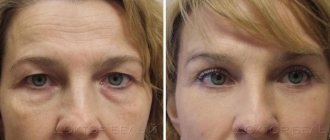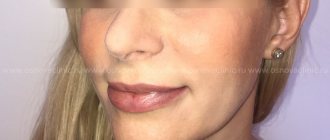Consultation with plastic surgeons with over 20 years of experience – free! Sign up by phone. Waiting for you! Blepharoplasty is an operation on the eyelids (Latin “blepharon” - eyelid). Any plastic surgery on the eyelids is called exactly this term – blepharoplasty. Eyelid surgery is a universal operation. It is done by both women and men. The operation, performed on the upper and lower eyelids, allows you to get rid of fine wrinkles, excess skin and fatty tissue around the eyes, that is, make the eyes more expressive, restore youth and freshness to the look. A separate type of operation is changing the shape of the eyes, which is usually used by people of the Eastern type who want to have a European appearance.
Indications for blepharoplasty
As a rule, the main indications include:
- excess skin in the eye area (“heavy, drooping eyelids”);
- eyelid wrinkles;
- so-called “bags” under the eyes - fatty hernias;
- less common indications are the desire to change the shape of the eyes, moving the angle of the eye, eye asymmetry;
- swollen eyelids.
Before surgery
Before performing the operation, the surgeon must have a conversation with the patient and find out if there are any possible abnormalities that may be a contraindication to plastic surgery. In addition, in some cases, the patient should undergo an ophthalmological examination (consultation with an ophthalmologist), which will make it possible to find out about the presence of possible eye pathology, if any, or if there is any suspicion.
During the consultation, the surgeon needs to find out the patient’s life history: medical history, previous surgical interventions. About past and existing diseases - diabetes, high blood pressure, hypothyroidism and others. About taking medications, about eating habits. The presence or presence of dry eye syndrome and the use of artificial tears, wearing glasses or contacts, and visual acuity should also be determined.
The story of a surgeon, Ph.D. Alexey Gvaramia about the operation - eyelid surgery (video)
More videos about this operation >>
Operation. Classic circular blepharoplasty
The operation is performed using general or local anesthesia. General anesthesia is used if the patient categorically does not accept local anesthesia. And, in our opinion, local anesthesia is preferable. Because during an operation, a surgeon sometimes asks a person to roll his eyes, sit down, open his mouth - in order to correctly determine the amount of tissue to be removed. Our clinic uses classical instruments, since the operation is standardized. “There are special tweezers with a more convenient tip, for example, but with some experience, you can get very good results with a standard set of tools,” comments Alexey Gvaramia.
The suture material used is non-absorbable
. Absorbable suture material is not advisable for such an operation for several reasons. As a rule, sutures from the eyelids are removed on the 3rd day after surgery, theoretically, they can be removed even the next day - the eyelids are an area where the sutures tighten very quickly. But the patient may hurt or rub his eyes, so we leave the stitches for three days, for greater guarantee. Absorbable threads take about a month to completely dissolve. Therefore, you should not leave a foreign body in the wound if it does not perform any function. This will lengthen the recovery period; additional time will be needed for the material to be reabsorbed, and where there is a long resorption, additional scars may form. Some surgeons even use glue. But our specialists prefer several neat seams. The thickness of the thread is like human hair; it is removed on the third day in one motion: it is simply pulled out.
The extent of correction of the upper eyelids is determined at the consultation, and markings are applied immediately before the operation. The amount of correction of the lower eyelids is determined during surgery. Excess skin is very important to excise accurately and with precision. If you remove too much tissue in the area of the upper eyelid, the eyelid will not close completely, and this is fraught with dry eye and, subsequently, a corneal transplant. And if too much tissue is excised in the lower eyelid area, a so-called lower eyelid inversion may occur.
Round eye is another problem that occurs when the amount of skin removed is incorrect. Another complication is hard scarring, when the edge of the lower eyelid bends under the influence of a pulling scar - this is quite rare and is corrected with special treatment. Therefore, it is extremely important to manage the patient in the postoperative period - at least after 2 weeks, when the process of active scarring begins, the patient must definitely visit the doctor so that he can understand whether additional treatment is required or not. Let us repeat, such cases are rare, but you need to protect yourself and take action in time if such a situation does arise.
Blepharoplasty by Alexander Peskov at the Mont Blanc Clinic
Aleko Gvaramia was re-elected rector of ASU
At the Abkhaz State University, at a meeting of the expanded composition of the Academic Council, elections of the rector were held.
By secret ballot, representatives of the Academic Council of ASU unanimously voted for the re-election of Aleko Gvaramia to the position of rector of the university, Apsnypress reports.
ASU Rector, Professor, Doctor of Physics and Mathematics, Academician of the Academy of Sciences of Abkhazia and the Adyghe International Academy of Sciences Aleko Gvaramia delivered a final report on the work of the university and a five-year program.
Gvaramia spoke about the difficulties ASU faces and proposed a number of solutions to these issues.
So, in particular, Aleko Gvaramia considers it necessary to adopt the Law on the Abkhaz State University as a national higher educational institution. In addition, the rector noted that the targeted university development program should be completed in the near future.
According to the rector, there are currently 44 departments operating at the university.
“For comparison, in the post-war period this number was 17. There are five scientific, educational and cultural centers at ASU. Over a five-year period, seven doctoral dissertations and eight candidate dissertations were defended. Achievement rates are at the level of 50-60%. But I am confident in the ability to improve these indicators. This will be facilitated by renovated educational buildings, equipped laboratories, as well as the resumption of library operations,” he said.
ASU will elect a rector
Today, February 28, the next rector elections will be held at the Abkhaz State University.
At an extended meeting of the Academic Council, in the presence of the President of Abkhazia Raul Khadzhimba, the current rector of the university, academician Aleko Gvaramia, will report on the work done and the program of activities for the next five years.
Elections of the university rector are carried out in accordance with the ASU charter.
The rector of ASU is elected on a competitive basis from among the citizens of the Republic of Armenia. He can be elected as a professor, doctor of science, who has worked in his main place of work at the Abkhaz State University for at least the last five years with experience in scientific and pedagogical activities of at least 10 years and speaks the state (Abkhaz) language. Elections of the Rector are carried out by members of the expanded Academic Council of the university by secret ballot.
The Academic Council of ASU includes 57 people - leading scientists, heads of university structures, as well as nine students.
According to Vice-Rector for Academic Affairs Victor Malandzia, the election of the rector will most likely be uncontested.
“We persuaded Aleko Alekseevich Gvaramia to nominate his candidacy again. He is in good shape, he has a lot of plans, he understands well the importance and significance of this work. I think that the Academic Council will approve the report and program of Aleko Alekseevich and will make a positive decision on the re-election of A. Gvaramia as rector,” he said.
Aleko Gvaramia has headed the Abkhaz State University since 1989.
Aleko Alekseevich Gvaramiya, professor, doctor of physical and mathematical sciences, academician of the Academy of Sciences of Abkhazia and the Adyghe International Academy of Sciences.
Gvaramia was born on September 7, 1940. in the village of Gup, Ochamchira district. He graduated from Tkuarchal secondary school No. 2 and entered the Sukhumi State Pedagogical Institute at the Faculty of Physics and Mathematics. From the third year I began to attend research seminars at the Department of Higher Algebra at Moscow State University. In my fourth year, I wrote my first scientific paper, which I presented at the All-Union Algebraic Colloquium at the Belarusian University.
He studied at the graduate school of Moscow State University at the Department of Algebra and Number Theory under the guidance of the famous algebraist L. Kulikov.
In 1967 in Moscow he defended his doctoral dissertation on the topic “Study of some classes of quasigroups with identities,” and in 1985 in Novosibirsk, at the Institute of Mathematics of the Siberian Branch of the USSR Academy of Sciences, he defended his doctoral dissertation on the topic “Axiomatized classes of quasigroups and multisorted universal algebra.”
For several years he worked at universities in Germany, where he trained four doctors of science. He gave lectures at 17 universities around the world (Moscow, Berlin, Leipzig, Potsdam, Sofia, Budapest, etc.).
He wrote a number of fundamental scientific works in the field of modern algebra, related to the solution of algorithmic problems and functional equations in quasigroups, the study of partial identities, various mappings of quasigroups, the establishment of criteria for the invariance of axiomatizable classes of quasigroups under isotopy, the description of classes of representations of groups and quasigroups, and various problems in the theory of multisorted algebra The research of A. A. Gvaramia connecting the theory of quasigroups with the abstract theory of automata opens up a new, promising direction in applied questions of mathematics.
In 1986, the Higher Attestation Commission under the Council of Ministers of the USSR awarded A. Gvaramia the academic title of professor.
Since 1989 - Rector of the Abkhaz State University.
He was elected as a deputy of the Supreme Council - Parliament of the Republic of Armenia of the first convocation (1991 - 1996).
In 1992, he was elected academician, member of the presidium, head of the department of mathematics, mechanics and computer science of the Adyghe International Academy of Sciences.
In 2010 – 2021 - Member of the Public Chamber of Abkhazia.
A. Gvaramia is a member of the European Rectors Club.
Added by: Admin Source: https://www.apsnylife.ru/syuzhe Date of publication: 02/28/2018 Return to news list
Technique for performing upper and lower blepharoplasty
Blepharoplasty of the upper and lower eyelids is performed on both women and men to eliminate excess skin in the upper and lower eyelid area. Often the removal of excess skin is accompanied by the removal of fatty hernias (so-called “bags under the eyes”), which give a tired appearance to even a fresh person.
The classic version of upper blepharoplasty involves a lower incision, which is made along the crease of the eyelid. Next, it is determined at what level the upper incision will be made so that the eye closes. It is very important to make the cut at the right level. Next, the surgeon excises excess skin, removes hernias (there are also different methods here - sometimes they are not removed, but immersed inside and sutured). There is also debate about how many hernias need to be removed. For example, ophthalmologists often say that plastic surgeons remove too many hernias, and sometimes they are right. After all, a fatty hernia is necessary fat; it performs a shock-absorbing function - it supports the eyeball in the socket. Therefore, you need to delete it so that the function is not affected.
Lower blepharoplasty can be done with an external incision, or with a transconjunctival one. With an external incision, the surgeon peels away the skin and muscle, removes fatty hernias, excises excess skin and muscle, and closes the incision with a cosmetic suture. Sometimes a so-called canthopexy is performed during surgery. The manipulation affects the canthus and reduces the risk of cicatricial eversion of the eye. It is indicated for those patients who have a flabby eyelid rib. Previously, sagging lower eyelid was an absolute contraindication to surgery; today all this can be corrected.
The operation of the upper and lower eyelids at the same time lasts from 1.4 to 2 hours. Most of the time is spent on the process of coagulation of blood vessels and capillaries to prevent bruising. Blepharoplasty of the upper eyelids is performed faster, about 40 minutes, since the volume of tissue removed is determined before the operation, and the surgeon operates according to the pattern. Lower eyelids – 1 hour or a little more.
Read more about upper eyelid surgery >>
Read more about lower eyelid surgery >>
“Having performed eyelid surgery for more than 20 years, I can say with confidence that there is nothing better than a scalpel for this operation. I'm talking specifically about the skin incision. This is what I and most of my colleagues think. If a laser or radio knife is used, small vessels are “welded”: this is convenient for the surgeon, since the wound does not bleed. But this affects the quality of the scar! And for the best scar, I prefer a scalpel. The laser is a wonderful device, but its use must be appropriate in aesthetic medicine.
Its use is justified in the transconjunctival technique, since the incision passes through the mucosa. But the final result in this case is not affected in any way by what exactly the doctor used to make the incision: it is solely a matter of the surgeon’s comfort.”
Excerpt characterizing Gvaramia, Aleko Alekseevich
“If he scolds, I’ll leave,” said Anatole. “I can’t stand these old people.” A? – Remember that everything depends on this for you. At this time, the arrival of the minister with his son was not only known in the maiden's room, but the appearance of both of them was already described in detail. Princess Marya sat alone in her room and tried in vain to overcome her inner agitation. “Why did they write, why did Lisa tell me about this? After all, this cannot be! - she said to herself, looking in the mirror. - How do I get out into the living room? Even if I liked him, I couldn’t be on my own with him now.” The thought of her father's gaze terrified her. The little princess and m lle Bourienne had already received all the necessary information from the maid Masha about what a ruddy, black-browed handsome minister’s son was, and about how daddy dragged them with force to the stairs, and he, like an eagle, walking three steps at a time, ran after him. Having received this information, the little princess and M lle Bourienne, still audible from the corridor with their animated voices, entered the princess’s room. – Ils sont arrives, Marieie, [They arrived, Marie,] do you know? - said the little princess, wobbling her belly and sitting heavily on the chair. She was no longer in the blouse in which she had sat in the morning, but she was wearing one of her best dresses; her head was carefully adorned, and there was a liveliness on her face, which, however, did not hide the drooping and deadened contours of her face. In the attire in which she usually wore to social gatherings in St. Petersburg, it was even more noticeable how much she had looked worse. M lle Bourienne also unnoticed some improvement in her outfit, which made her pretty, fresh face even more attractive. – Eh bien, et vous restez comme vous etes, chere princesse? – she spoke. – On va venir annoncer, que ces messieurs sont au salon; il faudra descendre, et vous ne faites pas un petit brin de toilette! [Well, are you still wearing what you were wearing, princess? Now they will come to say that they are out. We’ll have to go downstairs, but at least you’ll dress up a little!] The little princess got up from her chair, called the maid and hastily and cheerfully began to come up with an outfit for Princess Marya and put it into execution. Princess Marya felt insulted in her sense of self-worth by the fact that the arrival of her promised groom worried her, and she was even more insulted by the fact that both of her friends did not even imagine that it could be otherwise. To tell them how ashamed she was for herself and for them was to betray her anxiety; Moreover, to refuse the outfit that was offered to her would have led to lengthy jokes and insistence. She flushed, her beautiful eyes went out, her face became covered with spots, and with that ugly expression of victim that most often settled on her face, she surrendered to the power of m lle Bourienne and Lisa. Both women cared quite sincerely about making her beautiful. She was so bad that not one of them could think of competing with her; therefore, quite sincerely, with that naive and firm conviction of women that an outfit can make a face beautiful, they set about dressing her. “No, really, ma bonne amie, [my good friend], this dress is not good,” said Lisa, looking sideways at the princess from afar. - Tell me to serve, you have masaka there. Right! Well, this may be the fate of life is being decided. And this is too light, not good, no, not good! It was not the dress that was bad, but the face and the whole figure of the princess, but M lle Bourienne and the little princess did not feel this; It seemed to them that if they put a blue ribbon on their hair combed up, and pulled down a blue scarf from a brown dress, etc., then everything would be fine. They forgot that the frightened face and figure could not be changed, and therefore, no matter how they modified the frame and decoration of this face, the face itself remained pitiful and ugly. After two or three changes, to which Princess Marya obediently submitted, the minute she was combed up (a hairstyle that completely changed and spoiled her face), in a blue scarf and an elegant dress, the little princess walked around her a couple of times, with her small hand she straightened a fold of her dress here, tugged at a scarf there and looked, bowing her head, now from this side, now from the other. “No, that’s impossible,” she said decisively, clasping her hands. – Non, Marie, decidement ca ne vous va pas. Je vous aime mieux dans votre petite robe grise de tous les jours. Non, de grace, faites cela pour moi. [No, Marie, this definitely doesn’t suit you. I love you better in your gray everyday dress: please do this for me.] Katya,” she said to the maid, “bring the princess a gray dress, and see, m lle Bourienne, how I will arrange it,” she said with a smile of artistic anticipation joy. But when Katya brought the required dress, Princess Marya sat motionless in front of the mirror, looking at her face, and in the mirror she saw that there were tears in her eyes and that her mouth was trembling, preparing to sob.
Lipofilling for eyelid surgery
Lipofilling is used to fill the tear trough
so that it is not visible. Lipofilling is usually performed in the lower eyelid area. There are some features: lipofilling is not a one-time procedure. It must be carried out at least 3-4 times, since fat tends to dissolve and dissolve unevenly. Therefore, instead of lipofilling, injections of absorbable materials are now also performed. To remove the tear trough, you can redistribute the hernias isolated from the lower eyelids - this operation is called transposition of fatty hernias.
Lipofilling and lower blepharoplasty are two independent procedures; they can be performed either simultaneously or separately.
Fat is mainly taken from the inner or outer side of the thighs, abdomen - where there is excess fat. A special cannula is used, liposuction is performed, then the adipose tissue is divided into fractions and injected into the desired location using injections.
| MAGAZINES PERSONNEL ORGANIZATIONS CONFERENCES SEMINARS VIDEO LIBRARY AMSBIB PACKAGE |
| Gvaramia Aleko Alekseevich | In the Math-Net.Ru databases |
| Publications: | 13 |
| Scientific articles: | 12 |
| View statistics: | |
| This page: | 540 |
| Publication pages: | 2109 |
| Full texts: | 1034 |
| References: | 190 |
| 2. | E. Aladova, A. Gvaramia, B. Plotkin, E. Plotkin, T. Plotkin, “Logically-geometrical similarity for algebras and models with the same identities”, Proc. In-ta mat., 23:2 (2015), 112–122 |
| 2014 | |
| 3. | E. Aladova, A. Gvaramiya, B. Plotkin, T. Plotkin, “Multiple logic, models and logical geometry”, Fundam. and adj. Mat., 19:3 (2014), 5–22; E. Aladova, A. Gvaramia, B. Plotkin, T. Plotkin, “Multi-sorted logic, models, and logical geometry”, J. Math. Sci., 214:6 (2016), 742–754 |
| 2012 | |
| 4. | E. V. Aladova, A. A. Gvaramiya, B. I. Plotkin, “Logic of group representations”, Algebra and Logic, 51:1 (2012), 3–40; E. Aladova, A.A. Gvaramiya, B.I. Plotkin, “Logic in representations of groups”, Algebra and Logic, 51:1 (2012), 1–27 |
| 2009 | |
| 5. | A. A. Gvaramiya, B. I. Plotkin, “On linear representations of quasigroups”, Fundam. and adj. Mat., 15:3 (2009), 113–118; A.A. Gvaramia, B.I. Plotkin, “On linear representations of quasigroups”, J. Math. Sci., 168:1 (2010), 76–79 |
| 2005 | |
| 6. | A. A. Gvaramiya, B. I. Plotkin, “Classes of group representations axiomatized in the logic of action”, Fundam. and adj. Mat., 11:2 (2005), 73–85; A.A. Gvaramiya, B.I. Plotkin, “Action-type axiomatizable classes of group representations”, J. Math. Sci., 142:2 (2007), 1915–1922 |
| 1997 | |
| 7. | A. A. Gvaramiya, “Representations of quasigroups and quasigroup automata”, Fundam. and adj. Mat., 3:3 (1997), 775–800 |
| 1985 | |
| 8. | A. A. Gvaramiya, “Classes of quasigroups invariant under isotopy, and abstract classes of invertible automata”, Dokl. AN SSSR, 282:5 (1985), 1047–1051 |
| 9. | A. A. Gvaramiya, “Halmos algebras and axiomatizable classes of quasigroups”, Russian Math. A.A. Gvaramiya, “Halmos algebras and axiomatizable classes of quasi-groups”, Russian Math. Surveys, 40:4 (1985), 233–234 |
| 10. | A. A. Gvaramiya, “Quasivarieties of automata. Connections with quasigroups”, Sibirsk. math. Journal, 26:3 (1985), 11–30; A.A. Gvaramiya, “Quasivarieties of automata. Relations with quasigroups”, Siberian Math. J., 26:3 (1985), 315–331 |
| 1969 | |
| 11. | A. A. Gvaramiya, M. M. Glukhov, “Solution of basic algorithmic problems in some classes of quasigroups with identities”, Sibirsk. math. J., 10:2 (1969), 297–317; AA Gvaramiya, MM Glukhov, “A solution of the fundamental algorithmic problems in certain classes of quasigroups with identities”, Siberian Math. J., 10:2 (1969), 211–224 |
| 1967 | |
| 12. | A. A. Gvaramiya, M. M. Glukhov, “On algorithmic problems for some classes of quasigroups”, Dokl. AN SSSR, 177:1 (1967), 14–16 |
| 1968 | |
| 13. | V. D. Belousov, A. A. Gvaramiya, “First All-Union Symposium on the theory of quasigroups and its applications”, Uspekhi Mat. Nauk, 23:6(144) (1968), 197–199 |
- Abkhaz State University
| Feedback: | Terms of use | Registration of portal visitors | Logos | © Mathematical Institute named after. V. A. Steklova RAS, 2021 |
Transconjunctival blepharoplasty, eyelid correction
A gentle version of the operation is called transconjunctival blepharoplasty, which is performed with minimal incisions. However, in older patients, such an operation is impossible, this is due to age-related changes and general aging of the skin. Then the so-called “classic” type of operation is used.
This type of operation is performed without making skin incisions. All plastic surgery in this case consists of a small incision, a puncture from the mucous membrane, which allows access to the eyelid and leaves no traces of surgical intervention.
Transconjunctival blepharoplasty is indicated when the patient has no or very little excess skin, which is extremely rare. Usually such manipulation is carried out at a young age. In terms of technique, the operation is quite simple and is performed without external incisions. If there is still excess skin, it is necessary to supplement transconjunctival blepharoplasty with laser resurfacing. However, the result of laser resurfacing, unlike working with a scalpel, is unpredictable. It is impossible to guess how much the volume of tissue will change. You always need to make allowances for scarring, which depends on skin type, even nationality, and many other parameters.
Read more about transconjunctival eyelid surgery >>
Singapuri (Sangapuri) - plastic surgery for Asian eyes
In Russia, this operation is not performed as often as in Asian countries. There are several Singapura techniques, the operation is quite complex. The eastern eyelid, as a rule, is characterized by excess skin, the presence of fatty hernias, and the fact that in the eastern type of eye there is either no fold of the upper eyelid, or it is weakly expressed. Creating this fold so that it turns out really beautiful is not an easy process. There is another difficulty - the presence of epicanthus. In this case, the patient must be warned that when removing the epicanthus, a visible scar is possible, albeit insignificant and small.
More about Singapore >>
Recovery after blepharoplasty
Typically the recovery period goes as follows. The night after the operation should be spent calmly, in the clinic, and the next day you can put on smoked glasses (not black, this is important) and even go to work. If the job does not involve heavy physical exertion or prolonged work at the computer. If you can’t do without a computer, you need to use artificial tears so that the cornea does not dry out. It is enough to drop it into your eyes every half hour or hour so as not to experience discomfort. It is also not recommended to bend over, drink coffee and alcohol, and avoid exercise.
If we talk about upper or lower plastic surgery, swelling on the upper eyelids subsides faster, and scars disappear earlier on the lower eyelids, since the lower eyelids are static and the upper ones are mobile. To the most common question from patients: “When will I look normal after surgery?”, we answer: “In 2 weeks.” That is, 2 weeks is the time when strangers no longer pay attention to you, and acquaintances do not quite understand what happened to you. During this period, you can already use cosmetics (on the 10th day you are allowed to paint your eyes).
It should also be noted that there may be bruising after surgery. Within 2 weeks they completely disappear. But, most importantly, until the bruise has passed, it should not be exposed to direct sunlight, otherwise it will remain for a very long time. Some even say that you should not have surgery in the summer. This is wrong! But if you do it in the summer, you need to wait until the bruises go away, and until then use sunscreen, wear a hat with a large brim, and sunglasses so as not to expose the bruises to the sun.
Scars after eyelid surgery
Scars begin to form after about 2 weeks. At this time, you may feel a dense scar on the upper eyelid, the lower eyelid becomes dense, hard to the touch and, what is important, its ciliary edge is not sensitive. By the time the eyelids have become completely sensitive, we can talk about the end of the scarring process. This process goes differently for everyone. On average - from 3 to 6 months. At this time, we can already talk about the final result after the operation.
Limitations after eyelid surgery
The first 10 days should be spent in a calm, gentle manner. However, this does not mean that you need to lie down and not move. It is possible, and even recommended, to walk, the main thing is not to overexert yourself and not engage in heavy physical labor. You should limit salty foods, as salt retains fluid in the body. Do not drink strong coffee or drink alcohol for about 2 weeks. You cannot go to the bathhouse, the swimming pool, or take a hot bath at home.
Possible complications after eyelid surgery
I would like to note that one must always distinguish between actual complications and unsuccessful operations - these are two different things. Among the complications, scar deformation is possible: cicatricial eversion or some other hard scarring characteristic of a given person. This is normal, but the scar needs to be dealt with, especially since now there are a lot of methods for eliminating it - injections, irradiation. The most terrible complication is the so-called retrobulbar hematoma. This is a hematoma that has gone inside and can put pressure on the optic nerve. This complication is found in the literature. To avoid retrobulbar hematoma, very careful coagulation of blood vessels must be done during surgery, and anticoagulants should not be taken 2 weeks before surgery. Plus, following the post-operative regimen is of course very important. If complications do arise, they occur on the first day after surgery. And they quickly stop in the clinic.
An external hematoma is also possible, but it is eliminated quite quickly during the rehabilitation period. All other problems do not relate to postoperative complications, but to unsuccessful (or incorrectly performed) operations. These include dry eyes, “round eyes”, which occur due to excessive excision of tissue. Elimination of increased scarring must be addressed and not left to chance.
The key to a successful operation is the experience and professionalism of the surgeon performing it. Mont Blanc (clinic in Moscow) has accumulated extensive experience - more than one and a half thousand eyelid correction operations have been performed. Eyelid correction is performed by experienced plastic surgeons who specialize in facial rejuvenation.
Blepharoplasty
is an operation to correct the shape of the eyelids. Depending on which eyelid (lower or upper) it was performed, as well as the type of surgical intervention, the rehabilitation period after blepharoplasty depends.
Gvaramia Aleko Alekseevich (Aleko Gvaramia A.).
Born September 7, 1940. GUP Ochamchira region of Abkhazia.
He graduated from Tkvarcheli secondary school No. 2 and entered the Sukhumi State Pedagogical Institute at the Faculty of Mathematics. From the third year I began to attend research seminars at the Department of Higher Algebra at Moscow State University. In my fourth year, I wrote my first scientific paper, which I presented at the All-Union Algebraic Colloquium at the Belarusian University.
He studied in graduate school at the department of algebra and number theory under the guidance of the famous algebraist L. Kulikov. In the Moldavian Encyclopedia he was named one of the best students of the famous mathematician, Professor V. Belousov.
In 1967 in Moscow he defended his candidate's thesis on the topic “Study of some classes of quasigroups with identities”, his doctorate on the topic “Axiomatized classes of quasigroups and multisorted universal algebra” - in 1985 in Novosibirsk, at the Institute of Mathematics of the Siberian Branch of the USSR Academy of Sciences. For several years he worked at universities in Germany, where he trained four doctors of science. He gave lectures at 17 universities around the world (Moscow, Berlin, Leipzig, Potsdam, Sofia, Budapest and other universities).
He wrote a number of fundamental scientific works in the field of modern algebra, related to the solution of algorithmic problems and functional equations in quasigroups, the study of partial identities, various mappings of quasigroups, the establishment of criteria for the invariance of axiomatizable classes of quasigroups under isotopy, the description of classes of representations of groups and quasigroups, and various problems in the theory of multisorted algebra The research of A. A. Gvaramia connecting the theory of quasigroups with the abstract theory of automata opens up a new, promising direction in applied questions of mathematics.
In 1986, the Higher Attestation Commission under the Council of Ministers of the USSR awarded the academic title of professor.
Since 1989, he has served as rector of the Abkhaz State University. Thanks to his initiative and international authority, during the difficult years for Abkhazia, the Abkhaz University managed to establish educational and scientific ties with a number of universities and research centers in Russia and other countries. He was elected as a deputy of the Parliament of Abkhazia (1991-1996), actively participates in social and political processes in Abkhazia.
In 1992, he was elected academician, member of the presidium, head of the department of mathematics, mechanics and computer science of the Adyghe International Academy of Sciences (AMAN).
Since 2010 - member of the Public Chamber of Abkhazia.
General recommendations
General recommendations for the recovery period after blepharoplasty surgery are the same as after any surgical procedure. Only in this case does aesthetic beauty depend on the quality of the scarring process. Basic Requirement
– do not perform actions that provoke swelling after blepharoplasty. This means that for several days before and after the operation you will have to give up salty, spicy foods, and not drink a lot of liquid at night. It is also important to refrain from exercise and lead a calm lifestyle for a month after surgery. During physical activity, the intensity of blood flow increases, and blood flows to small vessels, including those on the face. It is especially important not to sit upside down, bend over, or do any work that involves lowering your head below waist level.
Restrictions on salty foods and alcohol are in effect for 2 weeks. Salt has the property of retaining moisture in the body, and alcohol dilates blood vessels, increasing blood flow to the capillaries. Both of these provoke swelling. For the same reason, during the rehabilitation period after blepharoplasty, you should refrain from visiting the bathhouse, sauna, or beach holiday.
The first weeks after surgery
After the stitches have been removed (usually on the 3rd day), you can begin to wash your face gently. But after each wash, it is necessary to treat the suture area with vodka or a 40% alcohol solution, or another antiseptic prescribed by a doctor. You cannot use alcohol-based cosmetic colognes or flavored vodka for this.
You can use your usual face creams, but they should be applied at least 5 cm away from the seams on the lower and (or) upper eyelids.
During the recovery period after blepharoplasty, minor bruising and swelling around the eyes is inevitable. They pass without a trace within 2 weeks. If you put on smoke glasses, you can return to your normal life already on the 2nd day after the operation - those around you will hardly notice any changes. But the glasses should be smoky, not dark.
Rehabilitation after blepharoplasty of the lower eyelids is easier and faster than in the case of the upper eyelids. An incision in the lower eyelid is made through the mucous membrane, and the mucous membrane is known to heal faster.
Going to work
Bruises and other external consequences of blepharoplasty completely disappear after about 2 weeks, at which time scars begin to form. But if you feel well, you can go back to work the very next day after the operation.
This is acceptable if the work does not involve heavy physical labor or long periods of work at the computer. The healing processes slightly reduce the reflex activity of the eyelids, blinking is not effective enough. Therefore, if you need to use a computer and look at the monitor, it is recommended to use drops such as “artificial tears” that moisten the cornea or still take a vacation while recovering from surgery.
Circular blepharoplasty with Alexey Gvaramia
When you see the “before” photos of the operation, you will understand that plastic surgery was my only option. Drooping eyelids on top, hernias under the lower eyelids - just a whole range of horrors. To be honest, I didn’t realize on my own that blepharoplasty could be done. A colleague at work gave me this idea. And then I told my daughter, she helped me solve this difficult problem for me.
I wasn't the one looking for a surgeon
My daughter herself found me a good plastic surgeon. Naturally, Masha (daughter) told me why she chose him and gave me information about him to read. We chose Alexei Gvaramia. He is a very competent doctor, one of the best Moscow surgeons in facial plastic surgery. I really liked the “before and after” photographs of his work; the result was immediately noticeable. I also watched a video on the Internet where Alexey Alekovich performed operations, explained all sorts of different things, and talked with patients. In short, I realized that this is exactly the specialist who will make me “beautiful.”
He is a very competent doctor, one of the best Moscow surgeons in facial plastic surgery
During the consultation, all my feelings were confirmed. A very competent doctor, he explains everything in detail, does not hold back information - he told me about all the risks. He asked about my state of health and examined me carefully. And most importantly, he explained what we can do and what results cannot be achieved. The result of our conversation was an agreement on the operation. Naturally, I first had to undergo tests that would confirm that I was healthy and would tolerate plastic surgery well. During the consultation, I realized that I was not mistaken in choosing a surgeon.
Day of surgery
You cannot eat or drink on the day of surgery. My surgery was scheduled for the morning, so I didn’t feel very hungry. They gave me anesthesia. And, before the operation, the anesthesiologist also comes to the ward and also has a consultation with him. We also talked with Alexey Alekovich, he put me in a positive mood, although I was already in joyful anticipation of the upcoming operation.
I woke up normally after the anesthesia, there was no discomfort. However, after you recover from anesthesia, you lie in the room for about an hour with a cold compress over your eyes. I decided to stay at the clinic overnight just in case, so I checked out the next day.
Rehabilitation after circumferential plastic surgery
There were bruises, there was swelling, but I wouldn’t say it was terrible. Everything is within adequate limits. During the first days, you must apply cold compresses. Then you still need to take anti-inflammatory drops for about 3-4 weeks. Nutrition also mattered - you need to avoid salty and spicy foods. You still can’t bend over or lift different weights. Otherwise, the seams may come apart due to increased blood pressure. I don’t remember now when the stitches were removed - probably 5-7 days after the operation.
Doctor Gvaramia did such a good job on my eyes, I think that in 5 years I’ll come to him to freshen up my face
My wish came true!
After 2 weeks, I already saw the result when the bruises went away and the swelling subsided. It's just a huge difference. I immediately felt 15 years younger, probably. The effect of the operation seemed so inspiring to me!
Naturally, now every time I look in the mirror, I thank Alexey Alekovich for his good work. Well, myself, for my determination. But now I’m still thinking about a facelift. Dr. Gvaramia did such a good job on my eyes, I think that in 5 years I’ll come to him to freshen up my face.









